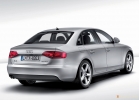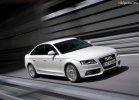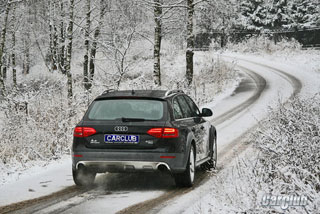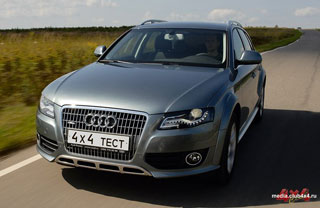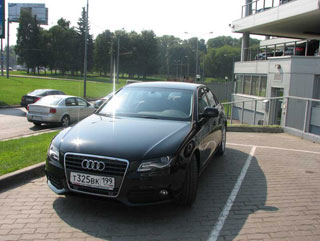Test drive Audi A4 B8 since 2007 sedan
They are called on ice ...
This time the goal of our test is not a presentation of new cars. All of them have already been presented in our magazine. Strictly speaking, the models collected for the test are not even classmates, only front -wheel drive unites them. Our task is to compare the handling, stability and safety of cars of the brands that are very common in Russia and choose the most corresponding to the characteristics of national operation in the winter.We have chosen the field of testing the field of an inactive airfield. The day before the test, a thaw occurred, then the frost that hit the frost turned liquid snow porridge into a rough rink. We decided that the runway covered with snow and in some places was a completely suitable place to solve our problem. And with safety at the airfield better - having lost control of the machine, you will not encounter anyone and you won’t crush anyone.
All cars were shod in all -season tires - naturally, unsolved, like most cars in Russia.
Peugeot 406 (motor 8, 1996). Designers divided the salon with color, as it were, at three levels. On top - the black plastic of the panel, in the middle - gray plastic and the gray cloth of the doors, below - again black plastic. It turned out a kind of puff cake. The seat reliably fixes the body while driving. There are only two adjustments, but the steering column is also regulated - this is more than enough for convenient planting. The windows are electric, there is an audio quote - the choice of the radio remains with the owner.
Volvo S40 (motor 8, 1996 and 10 (18), 1997) demonstrates a significant design separation from the company's familiar in the past of the company, which, nevertheless, is a machine of easily recognizable and not causing alarmed distrust. The Swedish salon is pleasant to the touch leather -plastic gray sheathing, comfortable lamb, wooden inserts, easily reached control handles, air conditioning, electric windows, electric grinders, radio. At first, there was a feeling of overload with buttons, handles and scales, but you get used to it quickly.
Compared to competitors, the Volkswagen Passat folk car (Motor 8 (16), 1997) looks simpler and stricter - both externally and in the interior (the version that turned out to have a minimum equipment). In addition, the car was inferior to the rivals in the engine liter. But the Audi corporate style is felt in the car. The driver's seat is comfortable, with good lateral support and a complete set of adjustments, the salon is practical and well finished ...
Audi A4 (Motor 4 (12), 1997) in our company is held apart - among the participants this is the most powerful (turbocharged (turbocharged makes itself felt) and expensive (about $ 38,000) car. Nevertheless, this is a machine of the same class, but with elements characteristic of more expensive and solid models.
The driver’s seat is with developed lateral support and a large number of adjustments, the slope of the steering column also changes, which allows you to get a very comfortable way. Of the items of luxury - the central castle, immobilizer, automatic air conditioning and audio kit.
We did not take any instrumental measurements - cars simply competed with each other. Given the fact that the skill of the drivers participating in the test was different, from time to time they changed cars to averaging the results. This is what we did.
We started with the races in a straight line, with a common start. Possessing the least powerful engine, Passat nevertheless won the rest of the distance at the first meters of the distance - it turned out to be easier to move in it, and while other cars skidded and polished the ice, Passat calmly and confidently moved forward.
But then inevitably a lower power, more precisely, the torque, inevitably affected. The first Passat always caught up and was ahead of the S40, for nothing that with an automatic box. This machine is equipped with a system for adjusting traction efforts (option), which ensures the redistribution of torque on the drive wheels when one of them slippage. On ice, the S40 was accelerated, of course, with slipping - I have not yet learned to imitate the spikes on tires, but it aligns the speed of rotation of the wheels well, providing the machine with stable acceleration and exchange rate stability.
After a set of speed and stabilization on the Passat road, other machines also walked. The turbocharged A4 went forward especially beautifully. Her first gear is slightly stretched compared to the rest and is well suited to start movement. A very even and smooth speed set in the atmospheric engine mode.
There is no sensation of the step when the boost is turned on - only a barely audible change in the tonality of sound under the hood. Thanks to good sound insulation of the motor compartment and salon, you sometimes forget to switch up and continue to accelerate in low gear, caught on only when looking at the tachometer.
But what about Madmoiselle? Actually, a 16-valve modification of 1.8 liters of a motor is not intended for our market. On the homologous Russian version of Peugeot 406, only an 8-valve power unit is used. But there are hot heads among domestic buyers, which prefer, albeit non -adapted, but more powerful cars.
On good asphalt, power increase is plus. On snowy ice - minus. The whole excess of power went underground - literally. Books!
Mirror under the wheels. Well, finally let's go. The car accelerated evenly, without jerking. At the same time, it was easy to keep a direct course. By the middle of the third program, Passat is overtaken. But by this moment A4 and S40 had already had a solid separation.
Passat rehabilitated itself in slippery turns and when maneuvering on a limited area, when the difference in car capacity does not play a special role.
Sensitive, predictable, he was well controlled at any speed. It practically did not roll in corners. Behavior is typical for a front -wheel drive car.
In the same way she behaved A4. Not surprising - the platform for cars is actually the same. A very clear steering wheel allowed the way to feel great. In corners on the asphalt, A4 kept fellow. The same thing - in the rolled snow with ice bald sabers. The car endured the speed of speed for a long time, and when the breakdown of the front wheels still occurred, it was well controlled by the actions of the gas and steering wheel pedal.
It seemed to some participants in the test that on the slippery coating after the demolition of the front axis A4 was aligned less willingly than Passat. This is most likely explained by the fact that under the hood A4 - extra 50 horses (and 70 nm), which are more difficult to control.
To disrupt in the skid S40 it turned out to be difficult - the electronics honestly worked out its number. This turned out only at a speed of about 70 km/h - with a sharply twisted barracks. No one in their right mind will perform such maneuvers on ice. At the same time, it was possible to get out of the side sliding without problems, manipulating the steering wheel and gas. ABS clearly fulfills its functions, if suddenly suffered in a bend - crush the brake, the system levels the machine. Here you need to return to the cabin - with a sharp change in the direction of movement, a chic upholstery made of gray leather glided as greased with a solidol, even lateral support did not help. The driver had to hold behind the wheel, and the passenger was great.
The presence of the rear elastokinematic suspension (a kind of revolution in the mechanics of the car) suggested that the PEUGEOT 406 would be in terms of controllability. However, snow, ice and non -navigated tires (conditions are equal to all) did not allow to evaluate the effect of steering wheel steering before the start of their demolition . The redistribution of the masses of the car, due to which the geometry of the rear trolley changes and the wheels are steamed, with a small coefficient of tire clutch, there is practically no road. But despite the fact that on the ice the suspension of the 406th loses its unique properties, the car confidently passed the turns of both large and low curvature. It was specially ...
Now let's try Mikst - dry asphalt and ice. Sharp braking and braking in the bend, when one side goes along the black and the other in white.
All machines in these braking modes occurred instant triggering ABS. All confidently slowed down on the line A4. But the car led, and had to correct it with the steering wheel. In this regard, the S40 turned out to be the most predictable - the slowdown happened smoothly, without the departure of the wheels. PEUGEOT 406 demonstrated perhaps the optimal set of slowdown with good course stability - its behavior seemed the best.
When braking in the bend, the French car again turned out to be more stable. Behind him is Swedish. The Germans (Passat and A4), flying in a skid from the ice platform on dry asphalt, were rolled so that it was possible to stay in the chair only by hanging on belts and clutching the steering wheel.
What about vertical accelerations?
Low - 10-15 cm - Passat snowdrifts overcame at any speed without visible efforts, maintaining the horizontal position of the body. At this stage, the S40 behaved the worst of all - flying on an obstacle, the Swede tried to shift it, and when it failed, it was tightly crossed through the hill.
When storming a snow fan at a slight angle of attack, Passat felt a strong return on the steering wheel. On A4, the jerk was almost the same, and on the 406th and S40 it was completely absent - powerful hydraulic power possessors absorbed the blow. During the intersection of the perpendicular course, the Passat ice multi -bearing track began to vibrate finely and unpleasantly, but - we must pay tribute to it - except for the tiles knocked out by his teeth, there were no other sounds in the cabin: the plastic elements of the skin were well fitted, and noise insulation at the height. In this situation, Peugeot was best. Its soft suspension extinguished any bumps, passengers did not have the slightest discomfort. But do not forget that the version presented for the test is not adapted to intensive operation on our roads.
Ask the adapted.
Summing up the dough, we argued for a long time, trying to lay out everything on numbered shelves. As it would be good - four shelves from top to bottom, and on each by car! It did not work out. Each of the cars has its advantages, and each has disadvantages. It turns out that the choice of a car for winter entirely depends on the temperament and experience of driving a particular consumer, as well as on the thickness of its wallet. People with a calm character will surely prefer the most automated Volvo S40 or stable, easy to control Volkswagen Passat; More temperamental, perhaps, will choose Peugeot 406, and hot heads will acquire Audi A4 if they understand that they are able to cope with a turbo version.
Sergey Ivanov, Alexey Kostyuk, Evgeny Romantovsky, Alexey Strelkov.
Source: Motor magazine [No. 1/1998]
Video test drives Audi A4 B8 since 2007
Video Crash tests Audi A4 B8 since 2007
Audi A4 B8 Test Drive since 2007
Audi A4 B8 Crash Test since 2007
Krassh Test: Detailed Information34%
Driver and passengers
14%
Pedestrians
41%
Children-passengers


